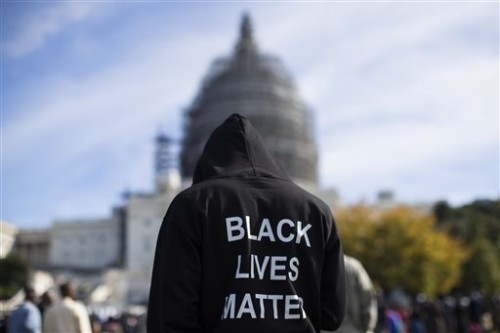
Clarence Lang, professor and chairperson of African and African American studies at the University of Kansas, spoke to students and interested faculty Thursday as part of the African and Black Diaspora Studies’ lecture series on Black Lives Matter movement.
His talk, about the “long shadow of the ’60s” continued the conversations students had last year among themselves, but related the Black Lives Matter movement to the Civil Rights Movement of the ’60s and policies and tactics in place that have hindered the growth of communities.
For Lang, the subject matter is one he’s familiar with. Though he’s written many books on the topics of race and race relations — as well as the perception of race in America — he grew up as the child of baby boomers in the South Loop, witnessing first hand the implications of policies and how they helped or hurt those around him in the “long shadow of the ’60s,” as his talk was called.
“The constant comparison between our contemporary moment and the ’60s not only distorts that past but it also substitutes the political creativity and imagination of today,” Lang said. “In the case of something like Black Lives Matter, the ’60s as a political and cultural point of reference can blind us to the challenges and the opportunities that face us in the early 21st century.”
The connections between Black Lives Matter and the civil rights movement of the ’60s are often featured in the media. The continuation of marches and community efforts to effect change and draw attention to the continued discrimination minorities, especially black people, face started in earnest after the death of Mike Brown in Ferguson last year in August.
However, the aims of the two movements could also be seen in regards to policy; the civil rights movement was one that wanted systemic changes in policies that allowed or turned a blind eye to policies that negatively effected life quality. Black Lives Matter is a response to the things that did not change — or that were swept under the rug — and the policies and institutions of the past that have not changed and have, in many ways, perpetuated the problem.
These policies, including the Housing and Urban Development Act of 1965 and the war on poverty, set out to change the system. Under President Johnson there was sweeping social reforms — the Civil Rights Act, the Housing and Urban Development Act, and the War on Poverty — but fixing what was already crooked proved even harder.
The most prevalent and detrimental of these was redlining, a tactic used by the Home Owners Loan Corporation, HOLC, and others to systematically deny goods and services to areas — largely black, largely low-income — they deemed unworthy. The ’60s, especially the Fair Housing Act of 1968, tried to redress the wrongs of the past by barring the outright racial discrimination of the ’40s and ’50s, but whether or not progress was achieved is questionable.
The term “redlining” emerged in the 1950s, after blacks and other minority groups migrated to the north for better job prospects. The process crippled neighborhoods, impeding their growth and prosperity, contributing to the poverty in the areas and the rise of row houses and public housing that continued through that time period and even today.
One of the most prevalent challenges Chicago faces is the continued segregation that plagues many of its sectors, most notably housing and education. However, the historical context begins even earlier than the ’60s, and some of the decisions made between the mid-1940s and the ’60s continue to hurt Chicagoans.
In his talk, Lang describes the ’60s as a historical category that surpasses the decade and extends from the mid-1950s to the mid-1970s. However, during the time of the Great Migration there were tactics in place to prohibit the kind of social progress LBJ would later try to enact.
“The policies of the period packed low-income families into public housing because there was increased racial and economic segregation policies with respect to poor folks,” William Sampson, professor and chairperson of the public policy studies department, said.
Remnants of the policies in the ’60s, but most importantly of the preceding periods, have lingered, said Adrienne Holloway, assistant professor in the School of Public Service. The effects can be seen in the quality of living and the access to resources seen in Englewood, West and East Garfield Parks and Lawndale to name a few. Holloway attributes some of this to the fact that the city and the areas surrounding it are still grappling with the implementation of affordable housing.
The “long shadow” of the ’60s is even longer than that but the things that predate that era, such as redlining, are worthy of attention due to their impact on policy and the lives of those in areas it directly affected. Those who chose to enforce redlining effectively decided who is in poverty and how they are then perceived.
North Lawndale, an area that was redlined during the ’40s and ’50s is one that continues to face poverty because the community was not allowed to flourish. Around 43 percent of those living in the area are below the poverty line, and 7.4 percent live in crowded housing, which is understandable because the area only has 14 total affordable housing complexes, eight of which were built to accommodate multi-families. East and West Garfield Parks, as well as Riverdale, face similar problems — according to data from Chicago’s data portal, in West Garfield Park, where the per capita murder rate is around 73 percent according to NBC, 41.7 percent of residents live below poverty and 9.4 percent of residents live in crowded housing. All faced discriminatory housing practices and the contiued segregation in Chicago may be continuign the shadow of the past, hindering growth.
Nationally, according to the poverty rate in 2012, blacks are the most impoverished at 27 percent. That poverty is also consolidated in areas that, in relation to areas other races may inhabit, are unable to keep up with the times.
Though the ’60s may cloud memories and perceptions of the civil rights movement, then and now, it also clouds perceptions of progress, Lang said. If the nation is to measure its progress, the ’60s would be a good measuring stick due to the reforms and the pushes for change and equality.
The major fault is that some remain in memoriam, in a deep-rooted nostalgia that heralds the ’60s as a time when anything was possible. For certain ethnic groups that was not the case. Today, the effects of redlining still jeopardizes success; it has limited the ability of neighborhoods to overcome their pasts economically, and has effected the ability of some families to get away from poverty, to move from the shadow and into the light.
The argument for the Black Lives Matter movement is entirely laid out in the name, but it is not just gun violence that black lives need to be protected from, it’s also policies that make advancement nearly impossible. In Chicago, this creates interesting possibilities and challenges for the road forward.
“If we’re to address the problems that low-income people see it’s going to require a lot more advocacy,” Holloway said. “(We’re seeing) more job deserts. Better paying jobs are lacking in these communities, and income determines where one can live. Housing costs are a dominant financial barrier to diverse economic dreams.”



